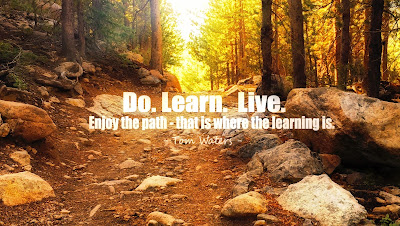Four Types of Scaffolding for Learning Challenges
Challenge is the spark of learning. Failure is inherent in the process. Failure can also destroy the process. The educator's role then is to present challenges, gauge the support needed, and then provide the right amount of scaffolding. Here are four ways to scaffold challenges, so learning occurs.
Challenge is the Spark of Learning.
 Learning theorists and psychologists from Bruner and Piaget to Gardner and Gagne speak of various forms of cognitive dissonance (take it for a quick Google). Simply, challenges. We're not going any further into the annals of research or psychology. They all say varying degrees of confusion, questions, and problems form the basis of motivation for learning. Challenges give us two options: learn or walk away.
Learning theorists and psychologists from Bruner and Piaget to Gardner and Gagne speak of various forms of cognitive dissonance (take it for a quick Google). Simply, challenges. We're not going any further into the annals of research or psychology. They all say varying degrees of confusion, questions, and problems form the basis of motivation for learning. Challenges give us two options: learn or walk away.
The educator's role then is to provide students with challenges. These come in the form of questions, problems, projects, or tasks. The difficulty is to match the degree of challenge to each students' readiness. That's a topic for another day. After the challenge, our job is to provide support. Some students will need more support, others will require less. Watch out! If a student requires no support, then the challenge is not enough, and learning is not optimal.
Four Types of Scaffolding
When a building is being constructed, temporary supports are put in place. These supports are called scaffolding. That is what teachers do during instruction. Here are four types of scaffolding we can build for learners to use temporarily while they are constructing new learning.
1. Peer Talk. Oh, it's so good to let your voice have a break! Even better, posing the right questions at the right time during whole class or small group instruction gives students scaffolding as they construct understanding in the challenges they face. Peer talk can be as simple as students recalling key facts, paraphrasing what was read, or even identifying points of confusion. When the teacher stops, and the students start talking engagement increases. The more students talk, the better the teacher can assess student understanding and guide the next steps of instruction (here's a discussion on why listening to student talk is among the best formative assessments). It's just like the scaffolding construction crews walk on to examine and plan the next steps of construction.
2. Writing. What? Writing? That's usually the hard part of learning. It's not the supportive part, right? True and not true. As a product are an assessment, writing is really complex for most learners. However, as a scaffold it's great. Here are some ways to use writing as a scaffold:
- During a whole class lesson, pause and let students write their thoughts. Open-ended. What's are you thinking? What is easy for you? What is confusing about my teaching? Writing, in this case, is a scaffold because it allows students to be vulnerable with their thinking in the safety of private writing. Then anyone who wants to share can do so with the support of their writing.
- Read-write-pair. Many times we have students pair and discuss what they've read. So many students aren't successful with this learning approach because talking is not their strength or because social interactions are intimidating. Writing allows them the opportunity to put their thoughts down on paper first, and it gives a support to face the challenge of pairing up for a discussion.
 |
| Scaffolding |
3. Team Games. Great for motivation and energy for the classroom, but they also embed scaffolding in two critical ways. First, they hide challenges in a game. Games take away the dread, risk, and fear that struggling learners generally, feel in traditional academic work. Instead, learners face the game with confidence and a mindset that is open and ready for learning! Second, inherent in team games is the peer support and encouragement associated with being on a team. "I don't have to face this challenge alone!"
4. Physical Movement. Here's another that we usually think of as a motivator or a strategy used to increase engagement. But an instructional support? Why of course. Brain research is mounting more and more evidence in support of the idea that physical activity increases the brain ability and activity. A stronger functioning brain = more learning. Here are two quick ways:
- Instead of giving 10 questions at their desks, post the questions around the room.
- Instead of providing visual supports on a PowerPoint, post them around the room. Have students do a walk-about note-taking session! As simple as that and students will more readily face the challenge of the task. This affective and emotional readiness is half the battle with any challenge. With that half of the challenge conquered, learning is that much closer!
Here are some other posts that have similar topics:
- "What Wrong With That?" a simple question demands rigorous thinking.
- Seven Things to Remember about feedback as an important part of scaffolding.



Comments
Post a Comment
What are your thoughts?